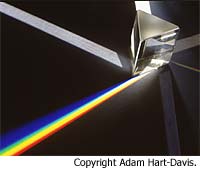Solar Micro Car Kit DIY STEM Kit
$9.99$4.95
 The connection between diffraction gratings and stars is found in spectroscopy, which is the study of the relative brightness of an object at each wavelength of light (electromagnetic radiation) it emits or absorbs. Each element has a unique 'fingerprint' determined by the allowable electron energies surrounding its nucleus, causing it to emit or absorb specific wavelengths of light.
The connection between diffraction gratings and stars is found in spectroscopy, which is the study of the relative brightness of an object at each wavelength of light (electromagnetic radiation) it emits or absorbs. Each element has a unique 'fingerprint' determined by the allowable electron energies surrounding its nucleus, causing it to emit or absorb specific wavelengths of light.
 A prism takes advantage of dispersion, which results from the fact that different colors of light travel through glass at different speeds, depending on wavelength.
A prism takes advantage of dispersion, which results from the fact that different colors of light travel through glass at different speeds, depending on wavelength.
 A diffraction grating can accomplish the same separation of colors because of diffraction. A light ray reflected (or transmitted) by a grooves in the grating will either interfere constructively or destructively with the ray from the groove next to it, depending on the angle it emerges and the light's wavelength. You can see this color separation by looking at white light reflected from the grooves of a CD.
A diffraction grating can accomplish the same separation of colors because of diffraction. A light ray reflected (or transmitted) by a grooves in the grating will either interfere constructively or destructively with the ray from the groove next to it, depending on the angle it emerges and the light's wavelength. You can see this color separation by looking at white light reflected from the grooves of a CD.
 'The true spirit of delight, the exaltation, the sense of being more than Man, which is the touchstone of the highest excellence, is to be found in mathematics as surely as in poetry.'
'The true spirit of delight, the exaltation, the sense of being more than Man, which is the touchstone of the highest excellence, is to be found in mathematics as surely as in poetry.'